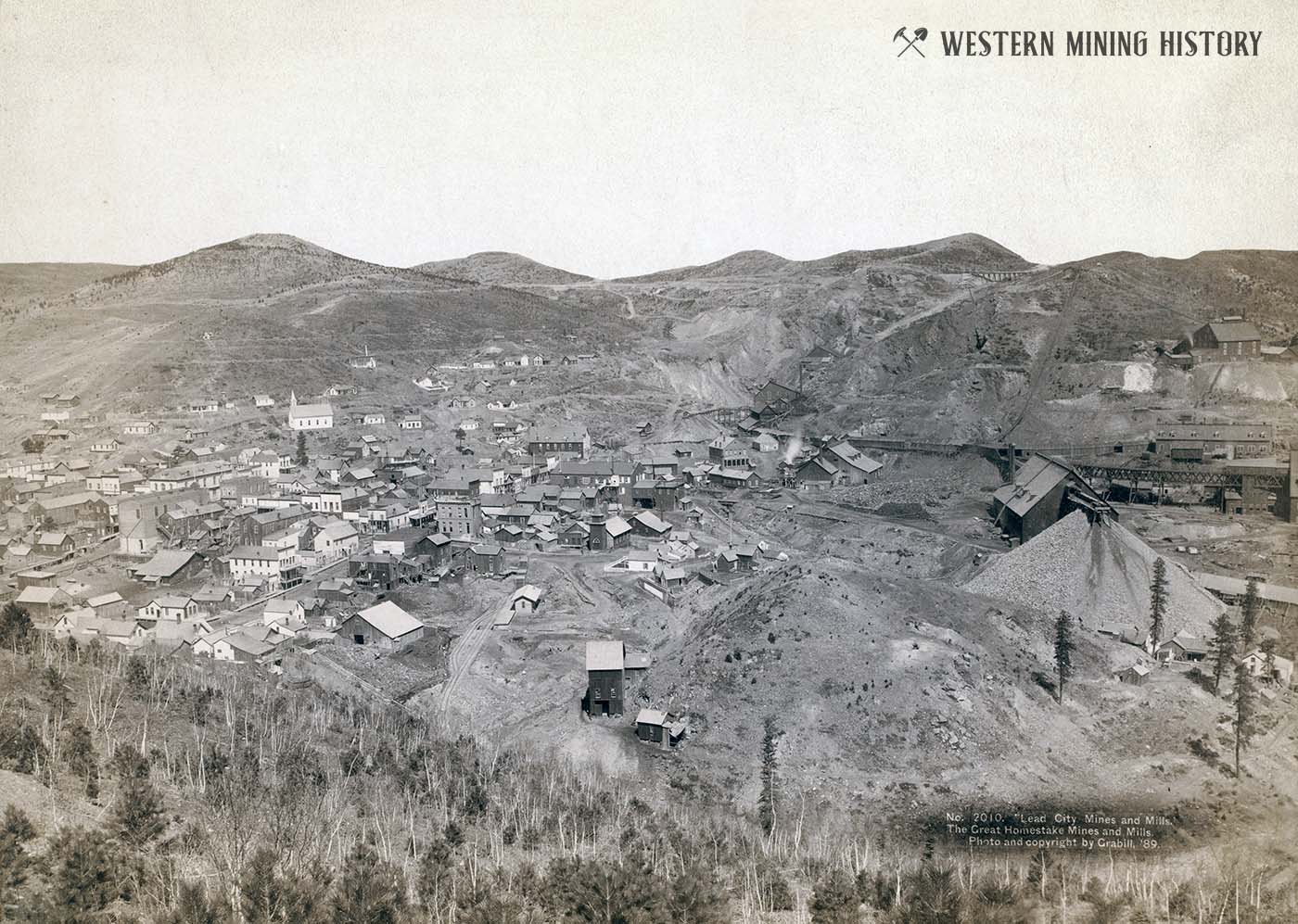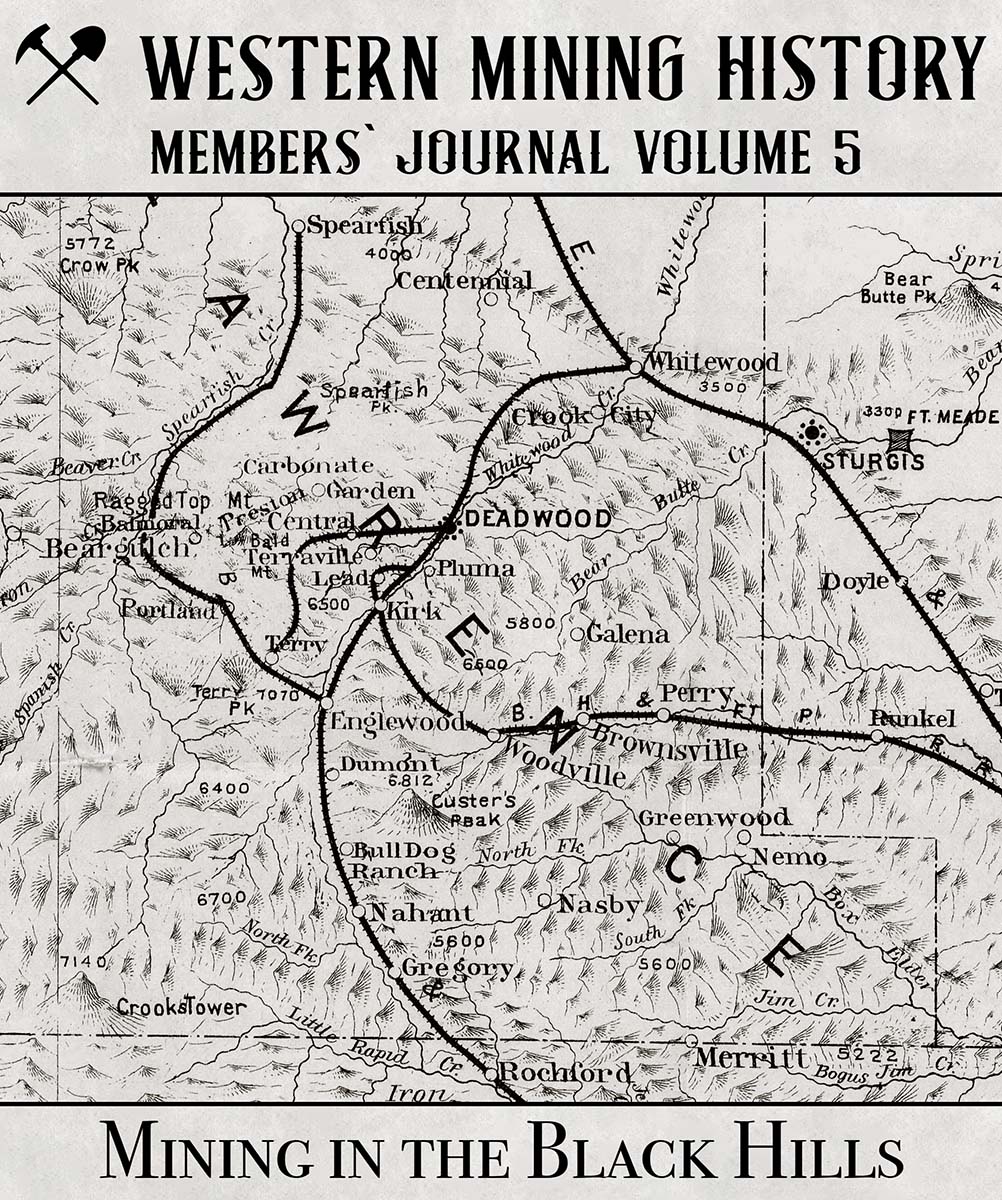Lead History
Lead City was settled in 1876. Although initially established at the site of gold placer mines, it was the town's proximity to the Homestake Mine that turned it into one of the West's greatest mining camps.

In 1880 the population was 1,437, but Lead became a major industrial city by the turn of the century, and by 1910 the census reported 8,210 residents. All of this growth was centered on the ever-expanding operations of the Homestake Mine - the nation's greatest gold mine.

In 1890, the citizens voted to change the name from "Lead City" to just "Lead".
A devastating fire burned much of the original city, built largely of wood, in March 1900. The business district was rebuilt of substantial stone and brick. The vast network of tunnels of the Homestake mine caused the ground to become unstable, and in the 1920s and 1930s entire blocks were demolished and much of the business district was moved to more stable ground.

Lead was an active mining city for over a century. The Homestake Mine finally closed in 2002, after producing over forty million ounces of gold over its 120+ years of operations.
In 1974, the Lead Historic District was created. The 580 acre historic district includes almost the entire city.

The Homestake Mine and the Development of Lead
The following text is from a historical sign in Lead, and describes the discovery of the Homestake Mine, the early development of the city, George Hearst's involvement in the area.
In the spring of 1876, the Manuel brothers found a good outcropping of gold ore which they named the Homestake, in the hope it was rich enough to send them home in style. Yet, even the Manuels never dreamed the mine would last for 125 years and yield over a billion dollars in gold.

Moses and Fred Manuel were French Canadians who had panned and mined for gold across the West. News of gold in the Black Hills lured them to Deadwood where they partnered with Hank Harney and Alexander Engh. Years later, Moses described their find in a fork of Gold Run Gulch just north of this location.
Toward spring, in the latter part of March or April, four of us found some rich float quartz. We looked for the lode but the snow was deep and could not find it. When the snow began to melt I wanted to go and hunt it up again but my three partners wouldn't look for it as they did not think it was worth anything.

I kept looking every day for nearly a week, and finally the snow melted on the hill and the water ran through the draw which crossed the lead and I saw some quartz in the bottom... I got some out and took it to camp and pounded it up and panned it and found it very rich. Next day Hank Harney consented to come and located what we called the Homestake, the 9th of April, 1876.
The Manuels were't alone. By mid-August, fifteen cabins, four general stores, two saloons, one blacksmith shop, and a brewery formed Lead City (pronounced "Leed"). In mining terms, a lead is a vein of ore.

After getting over $5,000 in gold out of the Homestake, the partners sold their claim. George Hearst and his partners in California bought the mine in July of 1877 for $70,000.
At age 57, Hearst was already a wealthy man from his mining investments throughout the West. He has been described as ambitious, flamboyant, shrewd, loud, and "a practical gold miner of the first water". With his riches he bought, and some say "bullied" his way into, over a dozen claims near the Homestake.

In May of 1878, Hearst wrote, "The Homestake mine will make perhaps the... best gold mine in the world." He also told his partners, "You nor your children will live to see the end of the time when this property will not be worked for a profit."
Both the mine and the city of Lead grew rapidly. Lead progressed from a camp of rough cabins and rough men to a permanent community. One writer noted, "The town (Lead) is the Homestake and the Homestake is the town."

In addition to providing jobs, the mine had a physical impact on Lead. As the mine expanded and the Open Cut grew, the town was moved. Partly dug by man, and partly created by subsidence, the Open Cut began devouring Lead City as early as 1895, and in 1911, part of Gold Street plunged down 300 feet. Over the years the Open Cut swallowed various parts of town. According to Irma Klock in LEAD CITY, "This is what has given the city its restless designation - it hasn't stayed put as do most towns.

Whole the ground around the Open Cut was unstable, the mine itself was very stable. It never experienced a major "bust." Because its vein of gold was vast, the Homestake didn't quickly play out.
The stability allowed the Homestake to be a good employer, reinforced by Phoebe Hearst's kindness and generosity. She supported all of the local churches, provided scholarships for education, established a free library, and started a Lead daycare program.

After George's death in 1891, Phoebe increased her involvement with both Lead and the mine. When she died of the flu in 1919, their son, William Randolph Hearst, sold his stock in the Homestake to support his publishing empire.
The miners pulled the last tone of ore from the Homestake on January 18, 2002. Since then, reclamation has restored the mill site into a park and wildlife habitat. The mine may be closed, but the city of Lead endures.
Lead's Historical Timeline: 1901-2002
The following timeline appears on a historcal marker and outlines events at Lead and the Homestake Mine from 1901 to 2002.
1901: "Cyanide Charlie" Merrill revolutionizes the process of extracting gold from tailings using cyanide.
1906: The first hydroelectric plant is put into operation at Englewood.
1907: A fire starts in the No. 5 Stope. It takes over 2 months and 80 million cubic feet of water to put it out.

1909-1910: A labor dispute and lockout closes Homestake for 2 months.
1910: Lead's population reaches 8,392 making it the 2nd largest city in South Dakota.
1914: Homestake celebrates the grand opening of Its Recreation Building and Opera House. The first coal-fired steam electrical generation plant is built in Lead.

1916: The Stamp Mills reach the highest number of ore-crushing stamps at 1,020.
1918: The Opera House and Recreation Building are used as an emergency hospital for flu patients.
1919: Phoebe Hearst dies of pneumonia. Her son, William Randolph, sells his Homestake stock.
1921: The South Mill is constructed and placed into operation. This plant served as the main ore-crushing site until the mine closed down and the building was demolished in 2002.

1934: The Ross Shaft is placed into operation.
1941: The Yates Shaft is placed into operation.
1942: The War Production Board orders all gold mines closed. Homestake's foundry and machine shops make items needed for WWII.
1945: WWII ends and mining resumes at Homestake.
1951: Homestake celebrates its 75th anniversary. Its 200 miles of underground workings reach 5000 feet below the surface.
1953: Rod and ball mills replace the last "roaring" stamp mill in Lead.

1954: The No. 4 Winze ‘opens up’ the deeper portions (below 5,000 feet) of the mine.
1968: Homestake is allowed to sell gold on the free market allowing the mine to become more profitable.
1970: Homestake discontinues the amalgamation gold recovery process at the mine.
1976: Homestake celebrates 100 years of operation with the underground workings extending to a depth of 1.5 miles.
1982: Mining resumes in the Open Cut area utilizing open pit mining methods.
1984: A fire destroys much of the historic Opera House.

1998: Mining in the Open Cut ceases.
2002: Homestake Mine closes after 126 years of operation.
Nearby Mining Towns
These are a selection of notable mining towns near Lead.
Central City
Central City, South Dakota was one of the Black Hills earliest, and most important mining settlements. In 1877, a conflict between the neighboring Aurora and Keets mines resulted in the death of one of the mine owners, and later the same year a strike at the Keets required intervention by Sheriff Seth Bullock and federal troops.
Deadwood
Deadwood, South Dakota is one of the West's most historically significant mining cities, and the location of some of the Wild West's most notable events. Deadwood has seen extensive preservation of its historical buildings, and is a popular tourist center.
Gayville
Gayville, South Dakota was one of the first mining communities formed during the 1876 gold rush at the Black Hills, Dakota Territory.
Mining in the Black Hills

Western Mining History Member's Journal Volume 5: "Mining in the Black Hills", takes a closer look at the distribution of mining districts and towns the Black Hills of South Dakota.
Deadwood: The Ultimate Photo Collection
The Black Hills Gold Rush was one of the most significant historical events in the western United States. Deadwood: The Ultimate Photo Collection contains over 50 images capturing the early history of this famous gold region.




